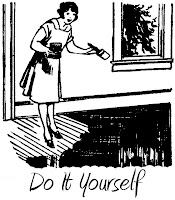
Remove home economics classes from school? Heck no! They are teaching valuable skills that our youngsters can use through out their lives. Still today, friends of mine who attended the same school as I did talk about that funny old duffel bag we made in Home EC. Every kid used that bag to tote their gym clothes to class. I still use techniques I learned in that class today.
But besides oddly shaped duffels, there are countless reasons that sewing is an essential skill for a thrifty gal. The most obvious reason is it saves you money!
The list of how goes on and on... You can hem your own pants. You can repair and save damaged clothing, housewares, and toys. You can make gifts, Halloween Costumes, or even party favors! You could save tons of loot on medical bills by doing you own surgery! (hehe just kidding) Here are some serious ways that learning to sew can help you save.
Skip the Tailor.
At least sometimes. If you are altering your wedding gown or if you've ripped a hole in a Chanel bag it is time to seek professional help. But for everyday issues, tailoring can be surprisingly simple. Hem your own skirts and pants. Change buttons on your clothes. Give a fitted shirt a little tuck, all with a little know how.
Repair and Care.
Avoid tossing clothes by extending their life. There are many simple sewing techniques that can be used to repair or reinforce your clothing. Replace buttons that have fallen off. Repair ripped seams. Fix frayed hems. Reattach belt loops that have popped off.
Gift Giving
There are so many charming gifts that you can make if you have basic sewing skills. Blankets, bags, head scarves, toys and more. Everyone loves getting a handmade gift. It's so personal and thoughtful. Check out the following resources for tutorials on simple hand sewn gifts.
Couture Galore
Making your own clothes is both rewarding and fun. You can make your own trendy, quality clothes once you really get into sewing. In the meantime, practice your sewing skills on your kids! Making kids clothing is a great way to become familiar with garment construction. The small projects go quickly and use up less material. When you feel ready, try tackling a simple skirt or dress for yourself. Before you know it, you'll be whipping up an entire handmade wardrobe! But take care, sewing your own clothes is not always cheaper than buying them pre-made. Fabric can get expensive, but the quality of the clothes you make may be better than what you grab off the rack at Walmart. Consider the price of each project as you go, and be a savvy shopper. Most fabric stores have mailing lists which can get you special coupons and discounts. For example, Joann Fabrics regularly send out 40% off coupons, good for any single cut of fabric. Their circulars and emails also let you know when things like notions, thread, and equipment go on sale. These savings add up, especially when you are making a big project. Also be sure to scope out the clearance and remnant sections of your fabric store regularly. Another tip: if you buy the end of a bolt of fabric, you can usually ask for a huge discount on the last yard of fabric. Use remnants and extra fabric to make kids clothes, toys, bags, and accessories.
How to Get Started
Start by picking up a needle and thread and learning to sew by hand. This method is slow, but essential for fine details, and for understanding the fundamentals of all types of sewing. After you have the hang of hand sewing, get on a machine! If you want help, check your local craft workshops, classifieds, or fabric stores for beginner's sewing classes. You can also be brave and try to teach yourself. The internet is a great source for information. There are countless videos, guides, and tutorials on basic sewing. Here are a few resources that may help:
If you prefer to learn from a book, the following titles are great for beginners. Check your local library for these or other titles on sewing. You may be surprised at what is available for free!










No comments:
Post a Comment